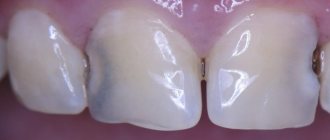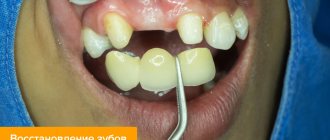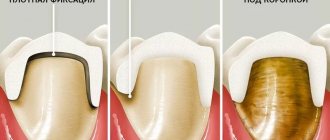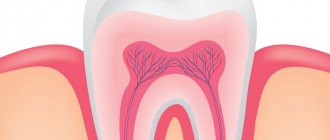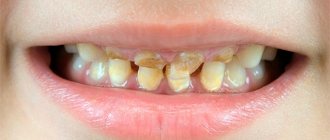Causes of crown loss
There are many factors that can cause a crown to fall out. The most common ones include:
- resorption of the cement composition that was used for fixation;
- breakage or abrasion;
- excessive pressure;
- the use of temporary material instead of permanent;
- formation of a carious process under the product;
- violation of the rules in the process of creating a structure or incorrect grinding of a dental unit.
A crown can fall off for several reasons. But only a specialist can determine what exactly led to this condition. In this case, you should not blame only the technician or the orthopedic surgeon. The patient himself can also become the culprit of the incident if all recommendations are not followed or due to negligence.
When the client contacts him again, the dentist must take a more responsible approach to the process of preparing the tooth for prosthetics and correctly fixing the structure using better quality material.
The dental technician, in turn, should not neglect all the rules and stages of creating a product. The patient is required to strictly follow all recommendations for oral care, perform high-quality hygiene procedures and exclude solid foods from the diet.
Why did the tooth darken? Dentist consultation
The copper-calcium hydroxide depophoresis method, which was used to treat the tooth, is an outdated method that always stains the teeth, so it is not used, especially in the aesthetically significant area of the front teeth. There are more progressive methods for treating dental cysts that do not give such side effects.
This is what the tooth looked like when contacting Dial-Dent:
The patient chose the restoration method and compared prices for crowns, veneers and direct artistic restoration on the Internet. For the price, direct restoration was more suitable for her. On the Family Dental website she found many works on artistic restoration of teeth, and she really liked the result. A young woman came to the dentist V.L. Ushakova at Dial-Dent with the desire to restore the front tooth and hide the dark color.
Upon examination, it turned out that all treatment was carried out through the inside of the tooth, that is, there are no fillings on the front surface, the tooth is absolutely intact. It would be a pity to prepare such a tooth for a crown, and direct restoration without grinding down the tooth will not be able to hide such a dark color.
Dentist-endodontist V.L. Ushakova suggested doing internal tooth whitening. With this option, the question arose about the need to reseal the canal. When whitening a tooth from the inside, the canals must be hermetically sealed so that the bleaching agent does not penetrate deep into the tooth and complications do not arise. Filling the canals with cement, as was done to the patient in another clinic, does not provide a seal, and over time the cement is destroyed, and infection can get into the canals, which will lead to inflammation of the bone tissue around the tooth.
To see how the canal is filled, an X-ray of the tooth was taken.
An X-ray of the tooth showed that the canal was not sealed hermetically. In this condition, internal bleaching cannot be performed; the tooth canal must be refilled.
Treatment plan:
- unsealing the tooth canal with access from the inside, treating the tooth under a microscope, filling the canal with hot gutta-percha,
- internal tooth whitening (several applications of whitening material until the desired result is achieved),
- installation of a seal.
The outer surface of the tooth will not be affected at all, which is very important for aesthetics!
Having received an estimate for treatment indicating the cost of all stages, their order and duration, the patient decided to have her tooth re-treated and whitened at Dial-Dent, since after the consultation she gained even more confidence in the clinic and the doctor.
What to do
If the crown falls out along with the pin, it is necessary to save the orthopedic product. It is not recommended to throw it away. To prevent deformation or damage, the structure is placed in a special container or box.
Since the stump of a dental unit becomes very fragile after treatment, it must be treated with extreme caution until the dentist installs the product again, since at this moment the risk of damage increases.
It is not recommended to put excessive chewing load on the tooth, or bite food with it. The hole in which the pin was placed must be covered with a cotton swab while eating.
All hygiene procedures before visiting a specialist are carried out carefully, the oral cavity is treated with an antiseptic solution.
Possible complications
A crown is a foreign structure that is inserted in place of an extracted tooth, so the prosthetic process can cause some complications:
- stomatitis;
- carious damage to supporting teeth;
- allergy to the construction material.
Stomatitis develops against the background of strong pressure of the crown on the gum. Due to pressure, blood circulation is disrupted and the process of tissue death begins. If such a reaction occurs, you should immediately visit a doctor. The problem is solved by creating a small gap between the implant and the gum.
With insufficient hygiene, food debris can get under the denture, which provokes an increase in the population of pathogenic microorganisms. As a result, caries may begin to spread to neighboring teeth. The problem may also arise due to improper installation of the prosthesis or improper preparation for installation of the structure.
An allergic reaction may not occur immediately after installation, but several weeks later. As a rule, this is accompanied by the formation of a rash on the oral mucosa.
Is it possible to glue a crown at home?
To place a crown or bridge, dentists use special materials that allow the orthodontic product to be temporarily or permanently secured.
Temporary type fixation is used to provide an opportunity to evaluate the structure while it is being worn. If there are no problems, the product is attached to permanent cement.
However, there are often cases when the crown falls out at home. The patient immediately begins to panic, especially if the crown was placed in the frontal area. In this case, there is no need to worry too much.
On this topic
- Crowns
Everything you need to know about temporary crowns
- Olga Alexandrovna Novikova
- October 4, 2020
To glue the product in place, you can purchase a gel at the pharmacy, which is similar in composition to the temporary cement used by orthopedists. It is applied from the inside and pressed against the tooth. After the material has hardened, the excess is carefully removed.
To get a permanent crown, it is important to visit your dentist without delay.
Extension on a pin
One of the ways to restore a damaged tooth is to strengthen the root with pins. They are made from fiberglass, metal and ceramics. The best are carbon fiber ones, consisting of tiny glass particles. They are flexible, durable and can withstand significant loads.
The pins are divided according to the installation method. Active ones are equipped with threads and are screwed directly into the root, without preliminary expansion of the channels. They are used for severe damage. Passive ones are attached to cement and used for minor damage.
Tooth extension onto a pin.
The installation of the pin takes place in one or two visits. It is carried out in several stages :
- Sanitation: caries and gum inflammation are cured.
- Preparation: the cavity is cleaned of damaged tissue and treated with an antiseptic.
- Installation of the pin: the rod is screwed into the root. In this case, the lower part should remain larger than the outer part.
- Restoration of the supragingival part: the dentist restores the tooth with composite materials.
- Grinding: excess parts of the filling are removed, rough areas are polished.
Important! It is recommended to restore a tooth with a pin if at least one wall is present. If the coronal part is completely destroyed, prosthetics are recommended.
Before restoration with a pin, X-rays are taken to determine the degree of destruction and exclude possible granulomas and cysts at the root apex. This type of restoration allows you to save the tooth for only 3 to 5 years. In addition, there is a risk of root splitting and caries development if the seal is insufficient. The rod is also difficult to remove without damaging the root system.
What will happen at the dentist's appointment?
At the patient's appointment, the doctor assesses the condition of the tooth root and stump. X-rays may also be required.
When the crown is not damaged, and the development of a carious process or any other pathological condition is not observed on the dental unit, the specialist immediately fixes the structure in place. If there are damages, therapeutic measures are taken to eliminate them and a new product is manufactured.
Events can develop in several directions, depending on the current situation:
- The flying crown is put back in place. To do this, at the first stage it is necessary to remove the remaining fixing material and treat the oral cavity with antiseptics. The methods used to prepare the tooth will depend on its condition. At the final stage, the structure is secured with dental cement.
- The dental unit is prepared for the creation of a new crown. In this case, the canals and tooth are treated again, defects are eliminated using special material, preparation and impression are made. It usually takes seven to ten days to produce a new product.
- The tooth is removed. This approach is provided in the case where there is complete destruction of the root and stump. The procedure is necessary, since a tooth that cannot be treated can provoke infection and the development of an inflammatory process. In this case, implants are used to restore the tooth after its complete removal. The procedure involves implanting a special screw made of metal into the bone tissue. After some time, when the element has taken root, an artificial prosthesis is fixed to it. This method is the most optimal, since in this case depulpation of adjacent dental units is not required. If implantation cannot be performed, which may be due to insufficient bone volume, then the patient is offered a single crown or bridge.
Many specialists provide a guarantee for their work. And if the crown falls off before the warranty period is still valid, then treatment measures are carried out, as a rule, free of charge at the expense of the clinic where the structure was originally installed. After the warranty expires, work is carried out at the patient's expense.
When is tooth augmentation performed?
Most often, pulpless teeth break. Deprived of nutrition, the walls become fragile and break off even under slight load. In such cases, they resort to tooth augmentation and prosthetics, since it is impossible to restore them with ordinary fillings.
Important! The sooner you go to the dentist with a broken tooth, the greater the chance of restoring it. Even if there is temporarily no money for restoration, the dentist will close the cavity with a filling upon request. This will protect the remaining tooth from further destruction and provide a short delay before the main treatment.
To restore a tooth from the root, certain conditions :
- Correct bite. When the dentition is bent, the load is not distributed evenly, which leads to rapid destruction of the restored unit.
- The length of the root should remain no less than the height of the supragingival part, and the thickness of its walls should be at least 1 mm.
- Absence of dental and gum diseases: granulomas, cysts, fistulas, caries, periodontitis, periodontal disease, periodontitis, pathological mobility and abrasion of the dentition.
- Satisfactory general condition of the body. Recovery is not carried out for tuberculosis, AIDS, cancer, or mental disorders.
- Relative contraindications are bruxism (involuntary grinding), poor hygiene and bad habits: opening bottles with teeth, cracking nuts, biting threads, nails.
Is it possible to prevent hair loss?
How long an orthopedic design will last will depend on many important factors:
- precise implementation of all rules and techniques at the crown manufacturing stage;
- quality of materials used;
- compliance with oral care recommendations
If the clinical and laboratory construction of the structure is of poor quality, it is possible that problems with loss will arise even if hygienic care was carried out in compliance with all the rules.
In the case when all the stages of creating a crown were followed exactly, the product was securely fixed, and the functions of the dental unit were completely restored, then the loss is possible only through the fault of the client himself.
To avoid complications, it is necessary to follow a number of recommendations, namely:
- brush every day using specially selected hygiene products;
- use not only toothpaste, but also mouth rinses
- prevent increased pressure exerted on the orthodontic product;
- solids and tough foods from the diet
- to remove stuck food ;
- regularly (at least once a year) visit a dental clinic for professional dental cleaning;
- a specialist every six months for preventative purposes.
Prevention measures
To protect yourself from such troubles, you must first of all maintain oral hygiene and try to eliminate traumatic factors. It is also important to pay sufficient attention to the condition of the enamel, regularly undergo preventive examinations at the dentist, periodically use strengthening hygiene products, and have professional cleaning to remove plaque and deposits every six months.
To strengthen your teeth, you should have your teeth professionally cleaned.
To keep your teeth strong and healthy, it is enough to follow the basic rules of oral care; eat more healthy foods rich in vitamins, fluoride and calcium; If possible, lead a healthy lifestyle. And remember that if a chip appears, you should immediately contact your dentist.
1Iordanishvili A.K. Clinical orthopedic dentistry, 2007.
Causes of the problem under different installations
FIRST OPTION: If after treatment the tooth pin falls out, what should you do? This case is extremely unpleasant.
It means that:
- or the preparation stage before inserting the pin was poorly carried out;
- or the root itself was in very poor condition.
The cause of the unpleasant situation may be the gradual destruction of the solid element after treatment, that is, an advanced situation. But sometimes it may not be clear to the average person what is happening inside the destruction. Yes, and it won’t be felt much, because the nervous apparatus is no longer there. Since to install a strong rod, it is necessary to prepare the canals in which the nerves must be removed.
SECOND OPTION: It happens that the crown with the pin falls out.
The reason may be:
- violations of rod fixation;
- violation of material fastening in the area of the additional tab.
To decide when a crown with a pin has fallen out, what to do next, you need to go to the dentist. There you will definitely have an x-ray taken to clarify the condition of the root part and determine the possibility of installing a new pin. If the pin with the crown falls out, then other types of prosthetics may be considered due to the poor condition of the root part and the impossibility of treating it.
